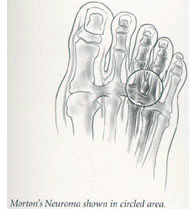Inter-Digital Neuroma
Definition

A neuroma is a benign tumour of a nerve. Morton's neuroma is not actually a tumour, but a thickening of the tissue that surrounds the digital nerve leading to the toes. It occurs as the nerve passes under the ligament connecting the toe bones (metatarsals) in the forefoot.
It most frequently develops between the third and fourth toes, usually in response to irritation, trauma or excessive pressure. The incidence of Morton's neuroma is 8 to 10 times greater in women than in men.
Signs and Symptoms:
If you sometimes feel that you are "walking on a marble," and you have persistent pain in the ball of your foot, you may have a condition called Morton's neuroma.
Normally, there are no outward signs, such as a lump, because this is not really a tumour. There is usually a burning pain in the ball of the foot that may radiate into the toes. The pain generally intensifies with activity or wearing shoes. Night pain is rare. There may also be numbness in the toes, or an unpleasant feeling in the toes. High-heeled shoes, which put the foot in a similar position to the push-off, can also aggravate the condition. Tight, narrow shoes also aggravate this condition by compressing the toe bones and pinching the nerve.
Diagnosis and Treatment
During the examination, your physician will feel for a palpable mass or a "click" between the bones. He or she will put pressure on the spaces between the toe bones to try to replicate the pain and look for calluses or evidence of stress fractures in the bones that might be the cause of the pain. Range of motion tests will help rule out arthritis or joint inflammations. X-rays may be required to rule out a stress fracture or arthritis of the joints that join the toes to the foot.
Initial therapies are non-surgical and relatively simple. They can involve one or more of the following treatments:
- Changes in footwear. Avoid high heels or tight shoes and wear wider shoes with lower heels and a soft sole. This enables the bones to spread out and may reduce pressure on the nerve, giving it time to heal.
- Orthoses. Custom shoe inserts and pads also help relieve irritation by lifting and separating the bones, reducing the pressure on the nerve.
- Injection. One or more injections of a corticosteroid medication can reduce the swelling and inflammation of the nerve, bringing some relief.
Several studies have shown that a combination of roomier, more comfortable shoes, nonsteroidal anti-inflammatory medication, custom foot orthoses and cortisone injections provide relief in over 80 percent of people with Morton's Neuroma.
If conservative treatment does not relieve your symptoms, your orthopaedic surgeon may discuss surgical treatment options with you. Surgery can resect a small portion of the nerve or release the tissue around the nerve, and generally involves a short recovery period.
Indication
Operative Procedure
The nerve can be approached through a longitudinal cut over the top of the foot between the toes, occasionally your surgeon might approach from the under surface of the foot (sole). Once through the skin and the through the fascia, a small segment of the nerve is removed. This procedure is usually done as a day case procedure mostly under general anaesthetic
Recovery
Recovery from this surgery needs to take into consideration any other operative procedures that were done in conjunction with this surgery. Patient can weight bear during this period. A bandage is worn for 2 weeks and once the wound is healed you can wear comfortable shoes.
Specific complications
- Infection around the surgical wound
- Blood Vessel (Vascular) Injury. There are small blood vessels that runs along the side of the nerve. If these are injured, the blood flow to the tip of the toe may be lost. This can result in necrosis of the tip of the toe. Although rare, this may lead to a partial amputation of the toe.
- Neuroma formation: The resected nerve end can grow and become sensitive this could result in reoccurrence of symptom’s and pain.
General Complications
- Wound healing problems
- Blood clots (DVT)
- Pulmonary embolism (PE): Although much less likely for toe surgery, blood clots and PE’s can still occur.